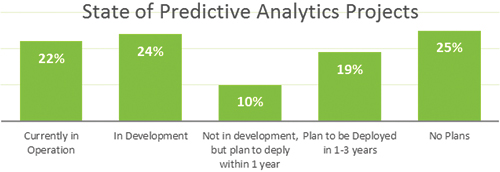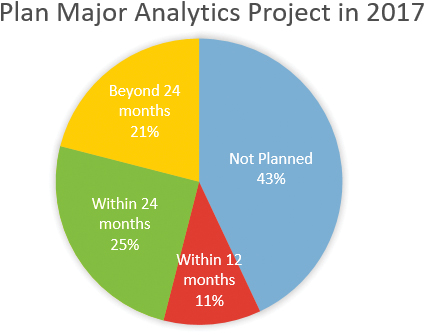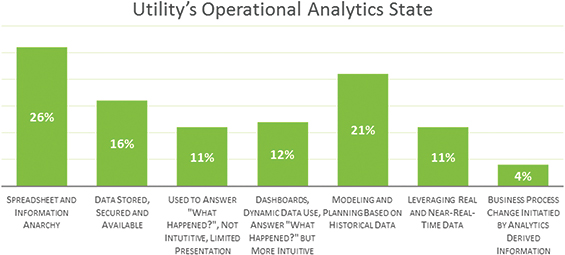Today’s utility industry stands on the precipice of discovering new insights that will transform the future of their business in terms of both strategic growth and operational efficiencies through the power of analytics. Specifically, the use of predictive analytics harbors enormous potential to help shape and transform the organization.
BRIDGE Energy Group’s recent BRIDGE Index® Survey on Grid Analytics confirms predictive analytics is going mainstream; nearly half the utilities surveyed indicated they have deployed or are developing predictive analytics. In fact, the survey shows that:

Source: BRIDGE Energy Group 2017 BRIDGE Index™ Survey
- 22% have predictive analytics in operation
- 24% are developing predictive capabilities
- Asset health (33%) and outage management (37%) comprise top use cases

However, there is still a gap. Only 36 percent of the survey participants indicated that they were planning a major analytics project within the next 24 months, leaving a significant majority of utilities without a plan. Also, striking, utilities that do have major projects planned have demonstrated a lack of maturity in their analytics program. 54 percent of survey participants indicated that their efforts to date have been done without business case justification. Survey participants also overwhelmingly responded to the current state of their organization as “spreadsheet and information anarchy.” Furthermore, a very small number of respondents reported that business process changes have resulted from their analytic efforts.
So why the gap between the potential of analytics and the progress with analytics? In part, it may be attributed to what is often viewed in utility organizations as the overwhelming prospect of collecting and extracting data across internal and external sources needed for analytics projects. Big Data is, in particular, a foundational requirement for advanced analytics programs looking to move towards predictive analytics.
However, a lack of in-house expertise can further exasperate the ability to evaluate gaps and determine use cases needed to solve specific business problems. Utility organizations can take the following measures to formalize an organization-wide direction to collect and analyze and use data for analytics.
Defining Your Vision & Strategy
Before launching an analytics project, utilities should ask and provide answers to these additional questions:
- What are we going to do?
- What type of a business challenge are we going to solve to gain high ROI?
- Can we justify the expense of the analytics project?
- Can we get the support of Business and IT departments to evaluate and access the integrity of the data to determine gaps that would impact execution?
- How would it meet the needs of future grid modernization efforts?
The answers to these questions will insure that your analytics initiative, large or small, has the right foundation from which to build. This focus on the core will also enable the organization to select and implement toolsets and frameworks that are reusable across the business.
Creating a vision for how your analytics program could improve your organization’s performance gives the sense of a greater purpose for what is to follow, beyond a single independent initiative. This phase should lead you to answers to “why are we doing this” and “where do we want to go.” The vision should also incorporate leadership’s view, both at the business level and at the executive level, of where the organization should be with analytics in three-to-five years. Such a vision must also take into account key process changes that would need to align with meeting that vision, including adoption strategies and change management.
The strategy phase requires a disciplined view of the vision as it relates to identifying where analytics could solve a pressing business challenge and validating the impact; a high return on investment (ROI) or a cost savings, will help further justify the expense of the project; Each use case should be evaluated by business and IT to determine required criteria including access to data, integrity of data, and organizational changes to business processes. This step will also allow leaders to discover gaps that would impact execution.

Source: BRIDGE Energy Group 2017 BRIDGE Index™ Survey
For utilities focused on maturing their analytics programs, part of the strategy will be to look beyond spreadsheets or vendor tools that only report ‘what happened.’ BRIDGE defines Predictive Analytics as using analytical tools to predict future operational conditions to prioritize where effort and capital would best be focused to deliver upon goals. In general, a core aspect of Predictive Analytics is using algorithms, for example in machine learning techniques, to analyze past situations to predict future situations. It is common to augment historical data with forecasted data from other sources for use in Predictive Analytics algorithms. For example, granular weather forecasts from external sources can be fed into algorithms to tweak dynamic line ratings.
Setting Priorities
With a holistic vision of your analytics program outlined and a strategy in place, the next step is to formulate the path you’ll take to get to that vision. Creating a road map will ensure that initiatives are prioritized across the organization with a clear focus on delivering value. The process will require:
- Continued planned activities
- Prioritization of use cases, based on existing organizational, technical and data competences
- Value and complexity associated with the business case
For operational analytics, the value will be determined by the possibilities of improving efficiency, reliability, or operational safety for the grid. For those utilities selecting use cases entrenched in new technologies, they should be aware of the higher risk -- and should evaluate how these use cases can -- or cannot -- fit into the finalized roadmap. If faced with this challenge, utilities can leverage a 2x2 matrix to select high impact use cases, which will require low efforts.
Delivering ROI
With budget constraints facing today’s utilities, long-term projects may not be easily accepted or financed. To avoid scrutiny and gain greater support, offer near-term wins that show the value of predictive analytics to solve business challenges and improve efficiencies. To succeed in this approach, it’s imperative that the project team works closely with the business clients to define and refine needs and requirements. Creating a collaborative development team that provides feedback at regular checkpoints, including weighing in on concepts, designs and finished products will also allow for a seamless transfer of knowledge across the organization.
To offer reliable results, utilities should also focus on a minimal viable product (MVP) concept, which will also help establish support for future projects, since the basic foundations have already been built.
Conclusion.
In the BRIDGE Index survey, the single highest concern was the availability of resources with the necessary skills. Almost as many respondents reported challenges with integration and existing tools. BRIDGE recommends that utilities expect to need multiple resources to provide the necessary skills and experience to get value from their analytics investments. For example, utility SMEs could work alongside analytic and tool experts to explore data, to define rules for automatically assessing potential issues, and to specify key metrics for summarizing the results. Other resources could be needed for specialty skills in visualization (including human factors) and change management.
As stated before, analytics projects will bring great success to utility organizations and offer tangible business strategies that can help define a clear direction for the organization. Furthermore, analytics initiatives in the modern utility can be used to define operational changes, efficiency improvements, retain human capital knowledge, and determine where capital will be spent.
About the Author
 Glen Sartain, VP of Grid Analytics at BRIDGE Energy Group, is responsible for strategy and design of analytic roadmaps and the implementation of these strategies. With more than 35 years experience in analytics and technology innovation for the energy sector, Sartain is recognized in the analytics community for his expertise in advancing analytic capabilities to help utilities improve operations.
Glen Sartain, VP of Grid Analytics at BRIDGE Energy Group, is responsible for strategy and design of analytic roadmaps and the implementation of these strategies. With more than 35 years experience in analytics and technology innovation for the energy sector, Sartain is recognized in the analytics community for his expertise in advancing analytic capabilities to help utilities improve operations.







